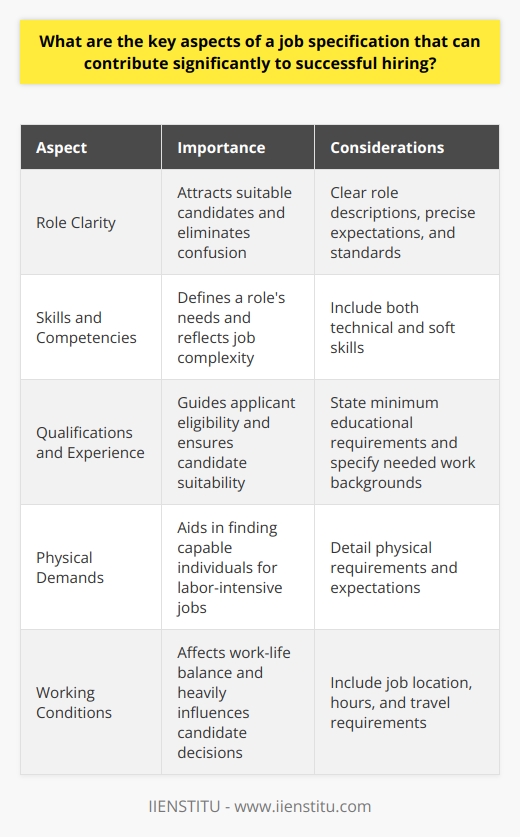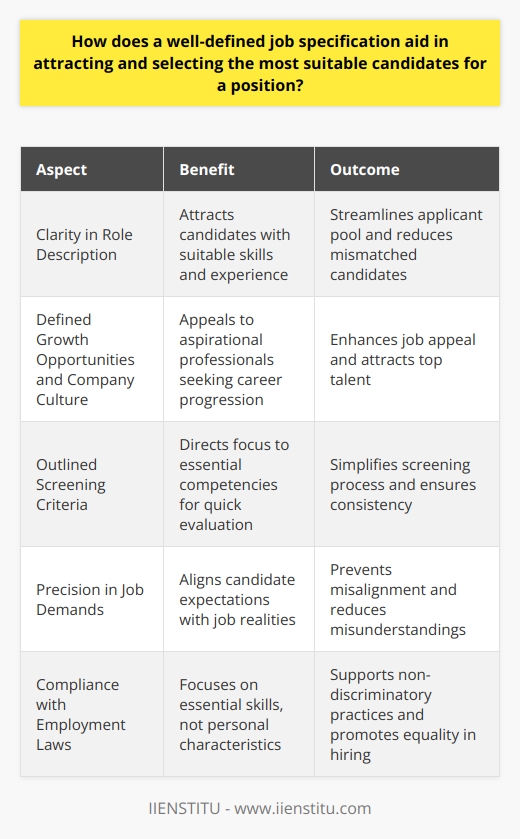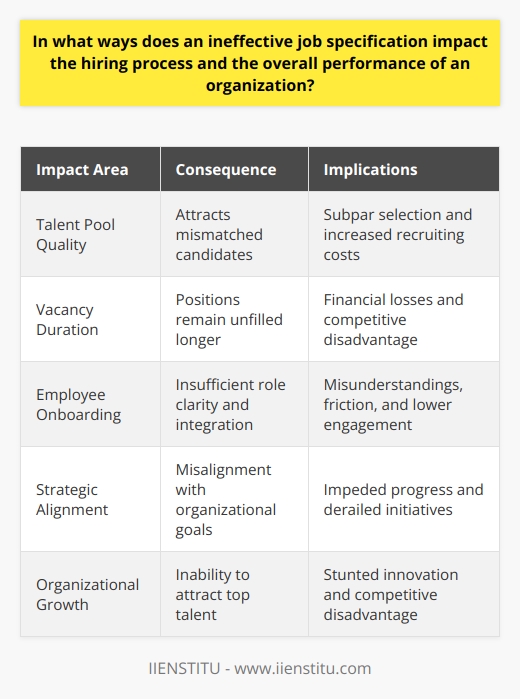
In the fast-paced, ever-changing landscape of modern business, the importance of a well-crafted job specification cannot be overstated. It serves as the foundation and guiding light for the entire hiring process, ensuring that HR professionals can effectively navigate the complex waters of talent acquisition and find the perfect candidate for each role.
Consider the cautionary tale of XYZ Inc., a mid-sized marketing agency. They had been experiencing high turnover rates and struggling to find the right fit for their open positions. Upon closer examination, they realized that their job specifications were vague, outdated, and misaligned with the actual responsibilities of the roles. By taking the time to revamp and refine these crucial documents, they were able to attract higher-quality candidates, improve retention rates, and boost overall team performance.
The Building Blocks of a Stellar Job Specification
A comprehensive job specification is a multifaceted document that encapsulates the essence of a role, painting a vivid picture of the ideal candidate and the expectations they will need to meet. Let's dive into its key components:
1. Job Title: The First Impression
The job title is the headline of your job specification - it's the first thing potential candidates will see, and it can make or break their interest in the role. A great job title should be:
Clear and concise: Avoid using internal jargon or overly creative titles that may confuse or alienate candidates
Descriptive: Accurately convey the level, scope, and main function of the role
Searchable: Incorporate commonly used industry terms to improve visibility on job boards and search engines
For example, instead of "Digital Ninja," opt for a more straightforward title like "Digital Marketing Specialist."
2. Job Summary: The Elevator Pitch
The job summary is your opportunity to hook potential candidates and get them excited about the role. In a few concise paragraphs, it should provide an overview of:
The role's primary purpose and how it contributes to the organization's overall goals
The key responsibilities and expected outcomes of the position
The unique selling points of the role and the company culture
Think of it as your elevator pitch - you want to capture the candidate's attention and leave them wanting to learn more.
3. Duties and Responsibilities: The Nitty-Gritty Details
This section is the heart of your job specification, providing a comprehensive breakdown of the day-to-day tasks, projects, and long-term objectives the role entails. To make it as impactful as possible:
Use strong action verbs to describe each responsibility (e.g., "Develop," "Analyze," "Coordinate")
Be specific and detailed about the scope and expectations of the role
Prioritize the most critical and frequently performed duties
Use bullet points for easy readability
For instance, instead of "Responsible for social media," try "Develop and execute a comprehensive social media strategy across multiple platforms to increase brand awareness and engagement."
4. Skills and Qualifications: Setting the Bar
This section outlines the non-negotiable requirements a candidate must possess to be considered for the role. Be sure to include:
Educational background and certifications
Years of experience in specific fields or industries
Technical skills and proficiencies
Soft skills and personal attributes that align with the company culture
It's crucial to strike a balance between being specific enough to attract qualified candidates and flexible enough to not deter potential top talent.
5. Work Environment: Setting the Scene
Help candidates envision themselves in the role by painting a picture of the work environment they can expect. This could include details about:
The physical workspace (e.g., open office layout, remote work opportunities)
The team structure, reporting lines, and collaborative nature of the role
The company culture, values, and mission
Any unique perks or benefits that set your organization apart
This section helps candidates assess their fit with the role and the company, ensuring a higher likelihood of job satisfaction and retention.
6. Salary Range and Benefits: The Bottom Line
Transparency around compensation and benefits is essential in attracting top talent and building trust with potential candidates. Make sure to include:
A realistic salary range based on market research and internal equity
Comprehensive benefits such as health insurance, retirement plans, and paid time off
Additional perks like flexible working hours, professional development opportunities, or wellness programs
Performance bonuses or equity options, if applicable
By being upfront about these details, you demonstrate your organization's commitment to fair compensation and employee well-being, setting the stage for a positive candidate experience.
The Many Hats of a Job Specification
A well-crafted job specification wears many hats throughout the hiring process, serving as a valuable tool for various stakeholders:
For HR Professionals: It acts as a roadmap, clearly defining the ideal candidate profile and guiding the development of targeted sourcing strategies.
For Hiring Managers: It provides a framework for evaluating resumes, conducting interviews, and making informed hiring decisions based on key qualifications and cultural fit.
For Candidates: It offers a transparent view of the role and the company, helping them determine if the opportunity aligns with their career goals and values.
For Employees: It serves as a benchmark for setting performance expectations, evaluating job performance, and identifying areas for growth and development.
By catering to the needs of these diverse audiences, a robust job specification streamlines communication, sets clear expectations, and lays the groundwork for a successful and mutually beneficial working relationship.
Job Specification vs. Job Description: A Tale of Two Documents
While job specifications and job descriptions are often used interchangeably, they are, in fact, two distinct documents with different purposes:
A job specification focuses on the ideal candidate, outlining the skills, qualifications, and attributes required to excel in the role.
A job description, on the other hand, focuses on the role itself, detailing the tasks, responsibilities, and day-to-day activities the position entails.
Understanding this distinction is crucial for HR professionals to effectively leverage these documents in their talent acquisition and management strategies.
The Perils of a Poor Job Specification
Neglecting to invest time and effort into crafting a comprehensive and accurate job specification can have far-reaching consequences for your organization:
Attracting unqualified or mismatched candidates, leading to wasted time and resources in the hiring process
Misaligned expectations between the new hire and the employer, resulting in job dissatisfaction and high turnover rates
Poor job performance due to a lack of clarity around roles and responsibilities
Difficulty in evaluating job performance and providing constructive feedback
Missed opportunities to attract top talent who may overlook a poorly written job specification
In today's competitive job market, a subpar job specification is a luxury no organization can afford.
Real-World Success Stories
The power of a well-crafted job specification is best illustrated through real-world examples of organizations that have reaped the benefits of investing in this crucial document:
ABC Tech Solutions: By revamping their job specifications to focus on key competencies and cultural fit rather than just years of experience, they were able to attract a diverse pool of highly skilled candidates and improve their time-to-hire by 25%.
XYZ Marketing Group: By incorporating detailed information about their company culture and values into their job specifications, they saw a significant increase in employee engagement and a 30% reduction in turnover rates within the first year.
123 Financial Services: By using job specifications as a basis for their performance management system, they were able to set clear expectations for employees and provide more meaningful feedback and support, resulting in a 15% increase in productivity across the board.
These success stories demonstrate the tangible impact a well-crafted job specification can have on an organization's bottom line and long-term growth.
In the high-stakes world of talent acquisition, a comprehensive and accurate job specification is not just a nice-to-have - it's a non-negotiable tool for success. By taking the time to carefully craft this document, you are setting your organization up for better hires, increased retention, and improved overall performance.
So, the next time you have an open position to fill, remember: a job specification is not just another piece of paperwork. It's a powerful strategic asset that can make or break your hiring success. Invest in it wisely, and watch your talent acquisition efforts soar!
Frequently Asked Questions
What are the key aspects of a job specification that can contribute significantly to successful hiring?
Job Specification: A Key to Successful Hiring
Understanding Job Specification
A job specification outlines requirements for a position. Employers detail necessary skills, experiences, and qualifications. This document guides both hiring managers and applicants.
Importance in Recruitment
Job specifications streamline recruitment. They ensure candidates understand roles. This clarity reduces unqualified applications. Thus, it saves time and resources.
Essential Aspects of Job Specification
Role Clarity is crucial. Clear role descriptions attract suitable candidates. It eliminates confusion. Precise expectations set a standard.
Skills and Competencies define a role's needs. They should reflect job complexity. Include both technical and soft skills.
Qualifications and Experience guide applicant eligibility. State minimum educational requirements. Specify needed work backgrounds.
Physical Demands often go overlooked. Detail these for labor-intensive jobs. It aids in finding capable individuals.
Working Conditions include job location, hours, and travel. They affect work-life balance. Candidates weigh these heavily.
Impact on Selection Process
Strong job specifications attract better fits. They filter out less suitable candidates. Companies find quality applicants faster.
Conclusion
Key aspects of job specifications greatly aid hiring. They detail role expectations and candidate requirements. Proper specifications ensure better, faster hires.

How does a well-defined job specification aid in attracting and selecting the most suitable candidates for a position?
Job Specification: The Hiring Magnet
HR professionals recognize the importance of a well-defined job specification. It serves as the cornerstone of the recruitment process. It aligns the hiring strategy with organizational goals.
Attracts the Right Talent
Clarity lures candidates. Job seekers look for role lucidity. They avoid vague listings. A clear job spec conveys precise expectations. It articulates requisite skills, experience, and qualifications.
Assists in Self-Selection
Applicants self-assess their fit. They compare their profiles with the spec. Mismatched candidates filter themselves out. This streamlines the applicant pool. It leaves only those who match closely.
Enhances Job Appeal
Catchy specifications stand out. They define growth opportunities and company culture. These factors are key for aspirational professionals. These candidates seek roles that promise career progression.
Simplifies Screening
Specifications outline screening criteria. They direct the focus to essential competencies. HR uses these criteria for quick evaluation. Candidates meeting criteria proceed. Others receive polite rejection.
Prevents Misalignment
Vague specs lead to poor hires. A precise spec leaves little room for misinterpretation. It ensures candidates understand the job's demands. Misunderstandings reduce. Candidate expectations align with job realities.
Creates a Stronger Employer Brand
A clear job spec showcases professionalism. It reflects a company's attention to detail. This boosts the employer's brand. Attractive brands draw top talent.
Standardizes Recruitment
Standard job specs ensure consistency. All candidates get measured against the same yardstick. It eliminates biases. Fairness in the hiring process increases.
Supports Legal Compliance
Precise specs support non-discriminatory practices. They promote equality in hiring. A spec focuses on essential skills, not personal characteristics. It facilitates compliance with employment laws.
Speeds Up Hiring
A good spec expedites the process. It directs applicants quickly through the pipeline. Recruiters waste less time on unsuitable candidates. They identify the right talent faster.
Conclusion
The importance of a precise job specification cannot be overstated. It acts as a magnet, attracting suitable candidates. It saves time and resources. It ensures the best fit. This, in turn, betters the organizational dynamics and productivity.
Let the job specification work for you. Aim for precision, clarity, and relevance. The result? A recruitment effort that locates the perfect candidate with ease.

In what ways does an ineffective job specification impact the hiring process and the overall performance of an organization?
Impact on the Hiring Process
Initial Misdirection
An ineffective job specification sets the stage for ambiguity. It fails to capture the actual role requirements. Candidates struggle to gauge the job's demands. As a result, many applicants may not fit the bill. Recruiters face a deluge of mismatched resumes. They then waste time sifting through these. The process bogs down quickly.
Poor-Quality Talent Pool
The talent pool's quality suffers. Prospects with the right skills may overlook the role. They find the job specification unclear. Those less qualified find their way in. This leads to a subpar selection.
Prolonged Vacancies
Positions remain unfilled for longer. Every day, the unfilled role costs the company money. Competitors might seize this slow hiring window. They can lure away potential talent. This puts the company at a strategic disadvantage.
Increased Recruiting Costs
Recruiting costs climb. More funds go into sourcing candidates. Interviews and assessments expand. These drive up the hiring budget. Return on investment drops sharply. The company's financial health could suffer.
Impact on Organizational Performance
Inadequate Onboarding
New hires struggle without clear job definitions. They receive insufficient onboarding. Their integration into teams becomes challenging. Misunderstandings about role expectations emerge. This creates friction among team members.
Lower Employee Engagement
Employee morale could plummet. Employees might feel misled by the job spec. Their tasks may not align with their expectations. Engagement takes a hit. Productivity often follows. The organization risks seeing a spike in turnover. Costs associated with turnover strain the budget further.
Misalignment with Strategic Goals
An effective workforce drives strategic goals. A poor job specification misdirects this effort. Employees cannot contribute to objectives they don't understand. This misalignment impedes progress. It may even derail the company's strategic initiatives.
Stunted Growth and Innovation
Organizational growth and innovation stagnate. The best candidates turn their attention elsewhere. In their absence, fresh ideas dwindle. Competitors with more persuasive job specs snap up top talent. They move ahead while the company struggles to keep pace.
In sum, a concise, clear, and effective job specification is vital. It ensures a smooth hiring process and strengthens organizational performance. Neglecting this foundational HR document can lead to a domino effect. This effect hinders both immediate hiring success and long-term company health.



